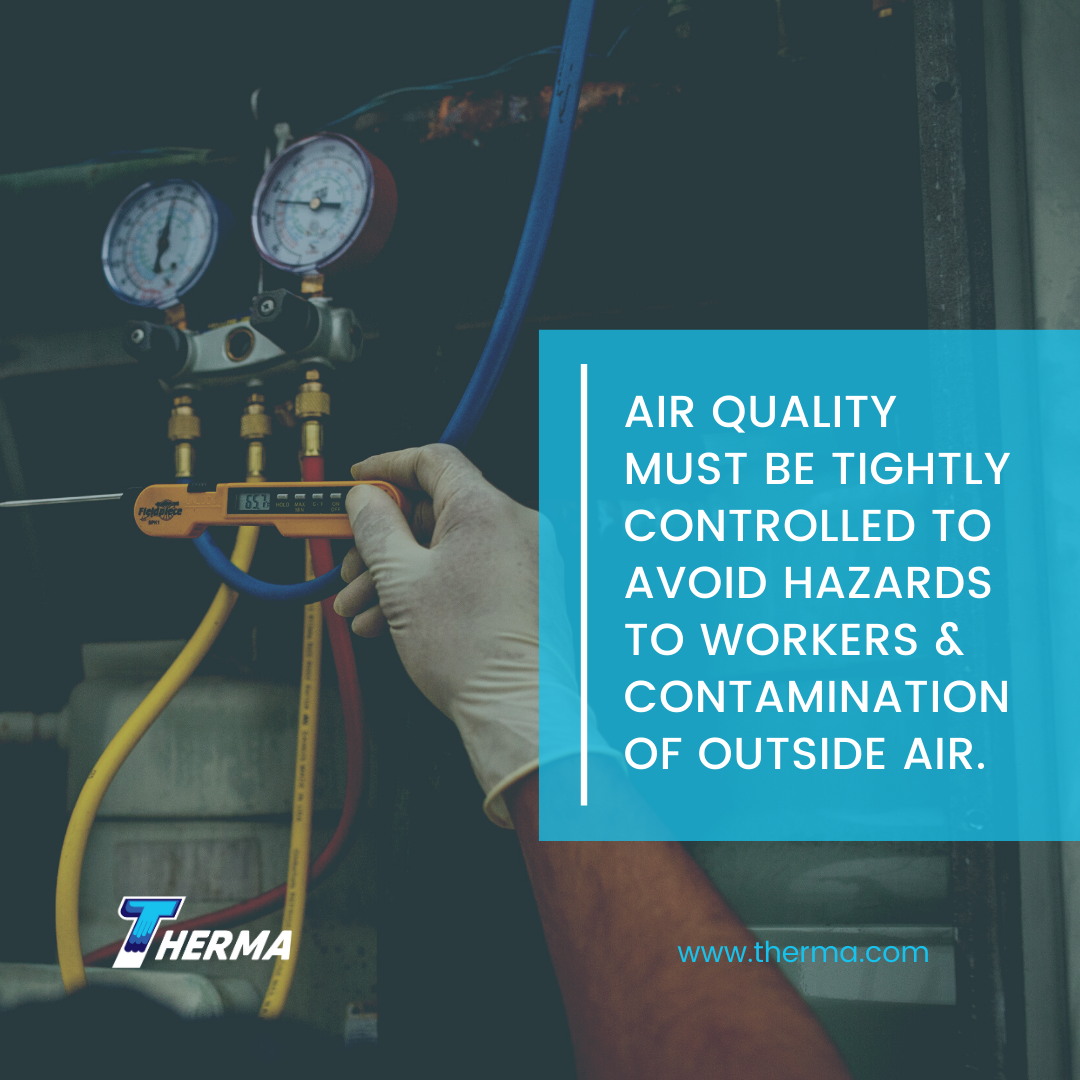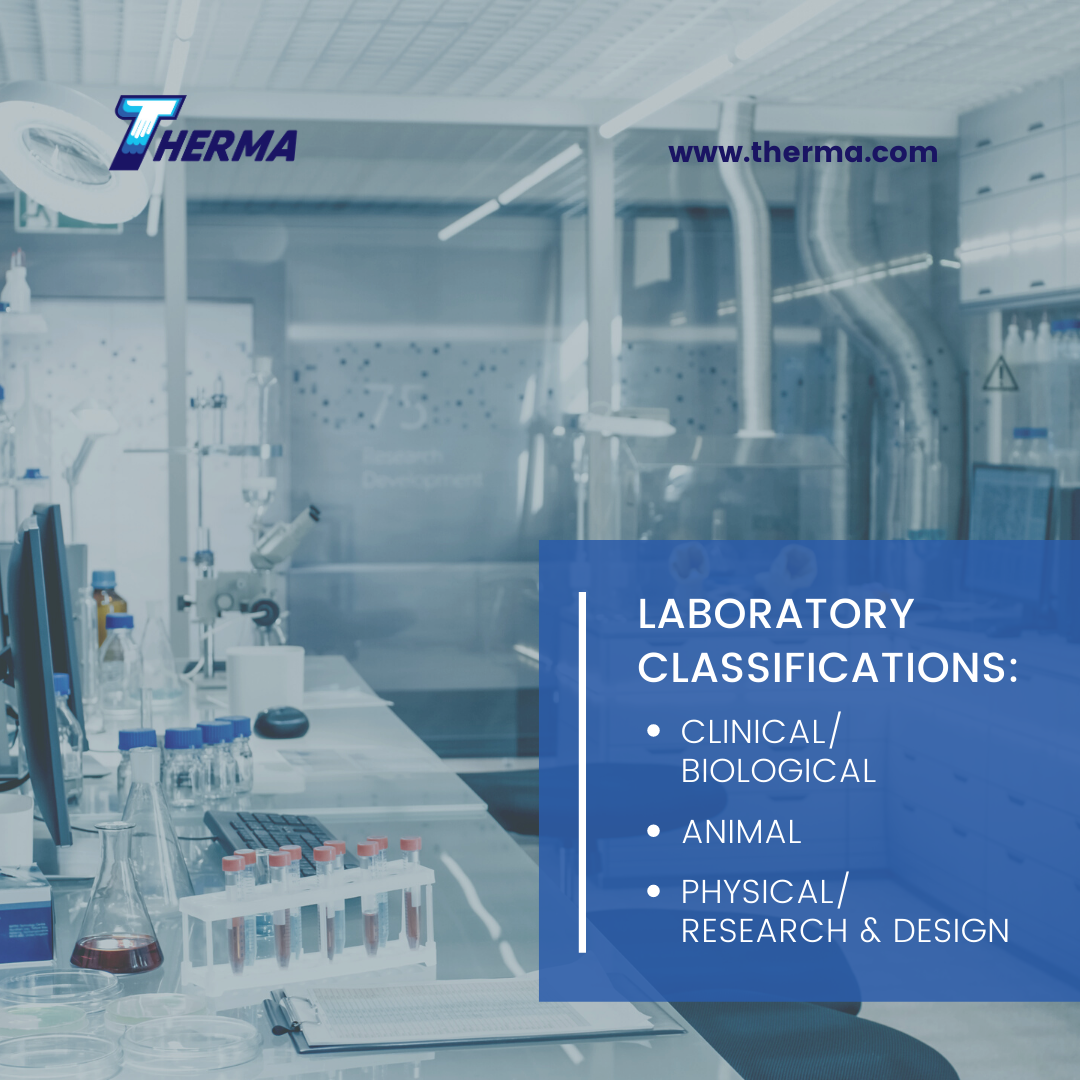HVAC for laboratories, there’s a lot to discuss here. Planning a laboratory layout from an HVAC design standpoint should be done with the goal of making each room and set up in the laboratory as safe as possible. Air quality must be tightly controlled to avoid hazards to workers and contamination of outside air.
Air quality standards
Air quality is classed both on its actual potential for harm as well as its offensiveness.
- Class 1 air can be recirculated or transferred to any other space. It has
- an inoffensive odor
- is unlikely to cause sensory irritation
- contains a low concentration of contaminants
- Class 2 air may be recirculated in its own space and recirculated or transferred to Class 3 or 4 spaces, but not to a Class 1 space. It may have
- a mildly offensive odor
- cause mild sensory irritation
- have a moderate concentration of contaminants
- Class 3 air may be recirculated in its own space, but not transferred to any other space. It may have
- an offensive odor
- cause significant sensory irritation
- have a considerable concentration of contaminants
- Class 4 air should not be recirculated or transferred to any other space, including its own. It may have
- highly objectionable fumes
- contain potentially dangerous particles, bioaerosols or gases at harmful levels of concentration
 Ventilation design levels
Ventilation design levels
The American Society of Heating, Refrigerating and Air Conditioning Engineers (ASHRAE) designates different Laboratory Ventilation Design Levels (LVDLs).
These guidelines recommend how to control laboratory-generated concentrations of airborne biological and chemical hazards with appropriate ventilation design, components and operating specifications.
The five Ventilation Safety Design Levels (VSDLs), range from VSDL0 (negligible airborne hazard risk) to VSDL5 (extreme airborne hazard risk). To appropriately ventilate laboratory space, a Laboratory Airflow System (LAC) must be created.
LACs typically consist of Exposure Control Devices (ECDs), air supply systems, air volume systems, exhaust systems and any other element of the laboratory that may affect control of airborne contaminants and/or airflow.
Variable Air Volume Systems (VAV) are energy-efficient and designed to deliver airflow at a variable rate while maintaining a controlled temperature, making them ideal for lab use. Laboratory HVAC systems should be designed to tie fume-hood exhaust with the room’s supply air and exhaust, to prevent contaminants from escaping.
 Laboratory classifications
Laboratory classifications
Labs are classified based on the type of materials and contaminants handled and the hazards posed. Laboratory classifications can be further broken down by industry.
Clinical / Biological
Clinical or biological labs can be classed on a biosafety level (BSL) scale from 0 to 4. Laboratories classed as BSL3 or above must have the means to safely exhaust biological safety cabinets and provide primary containment of microbiological hazards.
The requirements for these types of labs will meet or exceed requirements for most other types of active laboratories. Equipment will include
- High-efficiency particulate air (HEPA) filtration of cabinet air
- An ECD (such as a fume hood)
- A protective air curtain or a physical barrier (sash) between the cabinet’s workspace and the laboratory room
- An HVAC system designed to separate potentially contaminated laboratory air from areas outside the laboratory by
- Maintaining negative pressure in the BSL-3/ABSL-3 areas
- Preventing re-circulation of laboratory exhaust air to other areas
- Employing engineering controls capable of preventing laboratory airflow reversals under failure conditions
All directional airflow must pull air into the laboratory from “clean” areas toward “potentially contaminated” areas.
Animal
Animal lab requirements are similar to those for biological labs, with extra considerations for temperature and humidity control. Air change rates must be fairly high and airflow must be sufficient to keep animals healthy and comfortable.
Chemical
Chemical laboratories require both careful planning and execution to avoid contamination of air from the workspace to the room or from the exhaust system to “clean” parts of the facility.
ECDs may be more complex and require several different types of filtration to reduce risk. Fume hoods will require regular testing to ensure the HVAC system and VAV are operating at optimal efficiency. This is particularly important in large facilities with multiple fume hoods running simultaneously.
Physical / R&D
Physical or research and design labs may be more concerned with particulates from dust, mists and aerosols that require filtering out of the air than gaseous chemicals or biological substances. ECDs may not be required, especially in open-floor workspaces.
Personal protective equipment such as goggles, face shields, gloves and suits combined with an HVAC system that delivers strong filtration and high air change rates may be sufficient.
When designing an HVAC system for use in a laboratory, all of the above factors must be taken into account to ensure a safe environment. Following ASHRAE recommendations and directives from the CDC can help you plan and execute the best HVAC layout for optimal safety and efficiency.
To learn more about how the qualified technicians at Therma can help your design and install your laboratory’s HVAC system, get in touch today.







